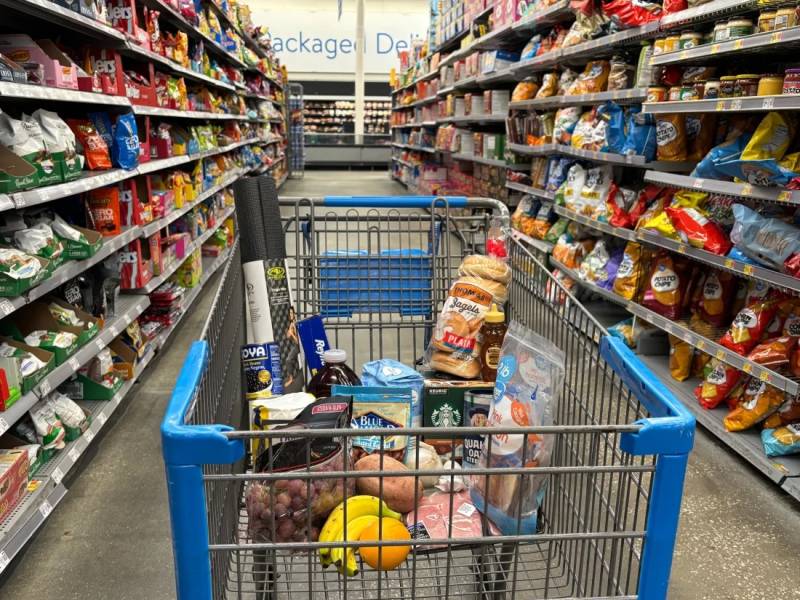On average, prices ticked up 0.7% last year
NPR’s list includes 96 items from virtually every Walmart aisle: chips and veggies, shampoo and T-shirts, dog food and paper towels. To account for changes in package sizes, we focus on the price per unit, typically per ounce, whether it’s toothpaste in a tube or soup in a can.
Over the course of 2024, the tracked prices on average increased just 0.7% — far less than overall annual inflation, which was 2.7% in November. (December’s inflation data will be released on Wednesday.)
That’s because exactly half of our tracked prices stayed the same from December 2023 to December 2024 — a notable relief after the COVID-19 pandemic, when most prices jumped year to year because of turmoil in supply chains and labor markets.
Twenty-one items in NPR’s shopping cart actually got cheaper during the year, including garlic, bananas and salmon. Another 27 products got more expensive, including eggs, ground beef and laundry detergent.
The 5-year view is much more painful
Items in NPR’s shopping cart are much pricier since mid-2019, our last check before the pandemic. On average, those tracked prices have increased around 25%. And that’s not far from federal inflation data: Cumulatively, U.S. prices are up 23% since 2019.
For example, a 4-pound bag of Domino sugar now costs $4.46. That’s 74% more compared with NPR’s visit to Walmart in 2019. A dozen eggs cost $4.90, or 83% more than they cost five years ago. Tide liquid laundry detergent now comes in a smaller container — 84 ounces instead of 100 ounces — but costs $1 more, in a classic case of shrinkflation. Regular family grocery runs add up.
Back in 2019, NPR’s visit to this suburban Walmart, near a large Army base, focused on the impact of then-President Donald Trump’s trade war with China. Our shopping cart was smaller, filled with many products either imported or made with imported parts. Only a few of those items have now gotten cheaper, including frozen shrimp, swai fish and — most dramatically — screwdrivers. (Walmart has switched brands, and the price is now 60% lower than it was.)
2019 prices will stay in the past
Big price increases are rarely followed by equally big price decreases, historically. That’s because seismic shifts in the global economy cannot simply be undone.
For example, it still costs more than it did in 2019 to ship things across the world. It costs more to fertilize soil where our food grows, because Russia is one of the biggest exporters of fertilizer. Prices have grown for paper and corrugated cardboard used in packaging. President Biden has largely kept Trump’s tariffs on Chinese imports, which means U.S. companies are paying higher import fees — and passing some of that cost on to shoppers.
Stores, factories, farms and warehouses are paying more for utilities and insurance. Gas prices affect the cost of trucking. American wages, on average, have outpaced inflation for more than a year and a half, with some wage increases affecting the cost of making, packing, selling and delivering our purchases.
Some items — like eggs, beef, chocolate and coffee — have faced specific troubles. Cases of avian flu have continued in chickens and cows. Dairy and cattle farmers also point to droughts increasing the cost of feed. Extreme weather has damaged harvests of coffee and cocoa, leading to record wholesale prices.
Here’s what Walmart and manufacturers had to say
NPR asked the companies that make the items in our shopping cart to explain their price increases. Some didn’t respond, including PepsiCo’s Frito-Lay, Eggland’s Best and Unilever, which makes Dove, Degree and Vaseline. And from those that did reply, we heard a common refrain: It simply costs more to make stuff.
The maker of Domino sugar, ASR Group, sent a detailed list of price increases it has faced since the start of the pandemic: general freight trucking costs up 19%, deep-sea shipping up 45%, rail-freight shipping 17%, wages 15%.
General Mills, whose Yoplait yogurt cup is 17 cents (or 28%) pricier than it was in mid-2019, said dairy inflation is worse than general inflation.
A 16-ounce jar of Jif peanut butter is 90 cents (or 41%) more than it was in mid-2019; its maker, J.M. Smucker, said shelled peanut prices rose about 44%.
Welch’s, whose grape jelly went up almost 68% since mid-2019, said many farmers in its cooperative went into the pandemic already financially struggling, prompting the company to “increase returns to growers” to sustain those family farms.
Many brands also said Walmart is the final arbiter of prices on its shelves.
Walmart does have the power to sell some popular items at break-even prices or even below cost, making up for the lost profits by charging a bit more for other products. But overall, supermarket prices are a complex amalgam of both the expenses and markups of manufacturers, wholesalers and the retailer as they respond to a myriad of factors, including harvests, seasons and shoppers’ loyalties.
Walmart, as the largest U.S. retailer, tends to extract lowest-priced deals from suppliers. In November, Walmart’s CEO said the chain had lowered prices on 6,000 items, half of which were groceries. Walmart’s scale also enables it to keep prices as stable as possible, which was a key reason NPR chose the chain for this project.
“We are committed to providing an Every Day Low Price experience both in stores and online,” a Walmart representative said in a written statement to NPR, “with the goal of having the lowest price on a basket of goods over time.”
Research and analysis by Alina Selyukh/NPR. Graphics by Juweek Adolphe/NPR.

